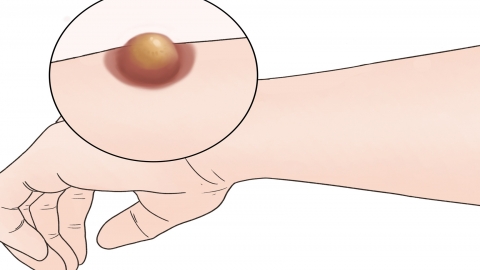What causes small, itchy blisters on the hands?
Small, itchy blisters on the hands may be caused by environmental factors, contact with irritants, tinea manuum (hand fungus), eczema, scabies, and other conditions. Management should be based on the specific situation. If physical discomfort occurs, it is recommended to seek medical attention at a hospital promptly and follow the doctor's instructions for treatment.

1. Environmental factors: In summer, hot weather causes excessive sweat gland secretion in the hands. When sweat does not drain properly, it may be retained under the skin forming small blisters accompanied by itching. These blisters often symmetrically appear on the palms and sides of the fingers. It is important to keep the hands clean and dry, avoid prolonged exposure to high-temperature environments, and use talcum powder appropriately to absorb sweat and reduce blister formation.
2. Contact with irritants: Frequent exposure to irritating chemicals such as dishwashing detergent, laundry powder, or disinfectants can cause allergic reactions on the skin of the hands, leading to small, itchy blisters. It is recommended to avoid direct contact with these substances and wear gloves while doing household chores. Rinse hands thoroughly with water and apply a gentle hand cream.
3. Tinea manuum (hand fungus): A fungal infection of the skin on the hands caused by dermatophytes can lead to inflammation, small blisters, noticeable itching, and scaling after the blisters dry up. It often affects one hand initially and can spread to the other. Patients may use clotrimazole cream, terbinafine hydrochloride cream, or itraconazole capsules under the guidance of a physician to alleviate symptoms.
4. Eczema: Skin inflammation caused by various internal and external factors such as diet, environment, and psychological stress may lead to red patches, papules, and small blisters on the hands. The itching is intense, skin lesions are polymorphic, and recurrence is common. It is recommended to use mometasone furoate cream, calamine lotion, or loratadine tablets as directed by a physician to relieve discomfort.
5. Scabies: Sarcoptes scabiei mites parasitize the epidermis of the skin on the hands and spread through direct contact. Tiny blisters ranging from the size of a pinhead to a grain of millet may appear in areas such as the finger webs and wrists, with intensified itching at night. Scabies burrows may be visible on the skin surface. Patients may use sulfur ointment, lindane cream, or crotamiton cream as directed by a physician to alleviate symptoms.
In daily life, it is recommended to focus on proper skincare, avoid contact with substances that may cause allergies or irritation, and maintain clean and dry hands.
References:
[1] Chinese Guidelines for the Diagnosis and Treatment of Tinea Manuum and Tinea Pedis (Popular Science Edition 2022)[J]. Chinese Journal of Mycology, 2022, 17(02): 89-93.
[2] Yang Fei, Chen Li, Yao Junli. Dietary Care for Childhood Eczema[J]. Guide to Women and Children's Health, 2025, 4(01): 12-14.






